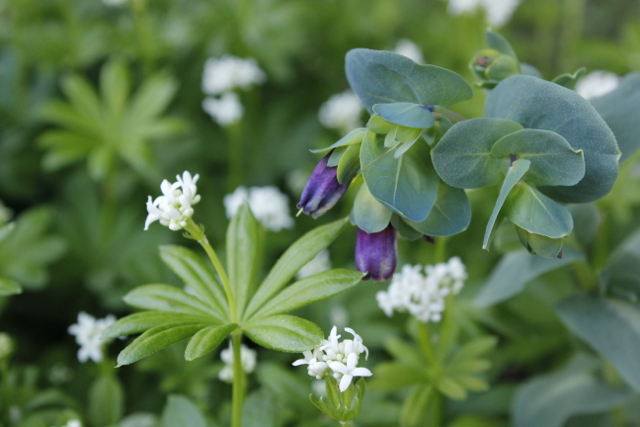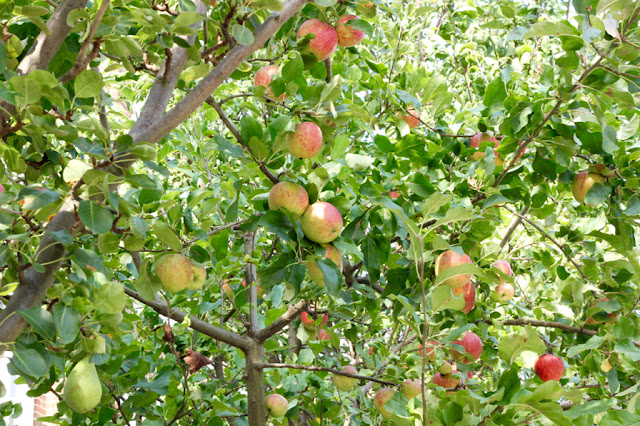Autumn is definitely upon us (despite the occasional chill sunny day) and with it the desire for soups and heartier warming food. Science says that with less daylight hours, our brains direct us towards eating more substantially to produce the happiness hormone serotonin.
I found celeriac for sale recently and was reminded of the delicious remoulade I'd eaten last summer at the Raymond Blanc Gardening School where all lunch ingredients are grown in the kitchen garden. At that time, I'd never tasted celeriac before but enjoyed the blended taste of celery, mustard, mayo and crème fraiche, the main ingredients in remoulade. I didn't think to look for celeriac afterwards but, seeing a pile of these root vegetables in the shops, I bought one with the intention of exploring whether I should be growing this vegetable next year.
Why grow your own
Putting aside that this supermarket wraps its root vegetables in plastic - (why? when they have to be peeled anyway?) - any veg that's home grown is going to be fresher, organic (I never use pesticides), and seasonal. I often conjure up meals inspired by what I can gather from the garden and anything freshly picked at this time of year is a welcome bonus.Having very little growing space, I have to make sure that whatever I plant will be a good return for my time investment, ie, be tasty, hard to source in the shops, and cheaper to grow myself. And packed with nutrients.
The nutritional benefits:
Celeriac is from the same plant family as celery so has a similar taste but is the bulbous root rather than the stem. I was amazed to discover that as well as being a good source of carbohydrate, the root has many health benefits to offer. So big tick in the box for that.- Useful minerals - phosphorus for healthy bones; potassium for detoxing cells, healthy nerve function (keep those stress levels down!), efficient muscle contraction and regulating the heartbeat; manganese for development and good metabolism.
- Useful vitamins: Celeriac is known to be an excellent source of Vitamin C which means that it's also anti-oxidant and anti-cancerous.
- Vitamin K; good for bone and brain health. Vitamin K improves the body's ability to absorb calcium and who wouldn't want good strong bones to counteract osteoporosis in later life? It's worth noting that 1 cup of celeriac contains 80% of recommended daily intake of vitamin K. More importantly, Vitamin K is fundamental in protecting the nerve endings in our brains which might limit the damage caused by Alzheimer's. I find that a reassuring thought.
- Low in calories; only 42 cals per 100 grams - useful as part of a weight loss regime. I found that Slimming World have a few recipes using celeriac, including a delicious sounding gratin.
Whew! Not bad for a lumpy root vegetable. I'm beginning to like it a lot.
In the kitchen:
Life can be so crazy busy that it's important for me to know that I'm not giving my family empty calories when I serve up dinner. Having a notebook of quick recipes gives me an alternative to microwave ready meals when time is short and ensures that meals are nutritious. Would celeriac be a good fit for my notebook? After a bit of research, it appears the answer is yes.
Am I the only person to be unaware of this workhorse winter vegetable? It's beginning to appear so. Celeriac is crisp when raw but is silky smooth when puréed. It can be roasted, sautéed, baked, grated, mashed, pickled or blitzed into soup. You can't do all that with a potato.
Online I found that it seems to be a favourite with the celebrity chefs:
- Celeriac and Bramley apple soup from chef Mark Hix
- Celeriac and Lancashire Cheese Pie (I'm keen to try this one - who doesn't love pie!)
- Celeriac and lentils with hazelnuts and mint is Yotam Ottolenghi's offering. I love that I can use bay, thyme and mint from the herb garden in this recipe, plus lentils are cheap and very nutritious.
- Whole roast celeriac with coriander seeds - said to be easy and pan scrapingly delicious!
- Nigel Slater cooks his with milk and adds smoked haddock for a fish soup.
- And for pudding/dessert? Scroll through this article for a Celeriac ice cream with a praline topping from Hugh Fearnley-Whittingstall. (I cater for all tastes here!)
Growing celeriac:
At the start of writing this post, I was sceptical of growing celeriac for myself. As with leeks and onions, with one seed you get one root so it's not exactly a space saving veg for the small garden, especially if they can be found locally in the shops. But now I'd say to give it a go; celeriac is obviously a versatile ingredient and will provide fresh vegetables at the onset of winter.- The seeds need to be started around March, sown onto good seed compost and left uncovered as they need light to germinate. Keep at an even temperature between 15°-18°C (60°-65°F) as they don't like extreme cold.
- Prick out the seedlings into modules as soon as they're big enough to handle to minimise root disturbance. By pricking out at an early stage, this should stop them bolting later on. Grow on under cover or indoors until they're about 10cm (4 inches) tall.
- Plant out after danger of frost has passed but grow under mesh or horticultural fleece to thwart celery leaf miner attacking the young plants. Some sort of slug prevention would also be useful; I use Strulch. If planting in the square foot method, put only one plant into one square, or nine to a square metre bed. Celeriac prefers humus rich, well manured soil - the no dig method is perfect for this. Keep the soil moist in a dry summer by watering well as celeriac is shallow rooted and won't bulk up if it dries out.
- As the celeriac grows, remove the outer leaves to expose the crown of the bulb and encourage it to develop. Harvest is usually from October onwards; grower's choice whether to dig up when needed, leaving the remaining bulbs in the ground - or, if there's a slug problem, harvesting all at the same time and storing in boxes in a cool place.
Adding to the planting plan:
In conclusion, I'd say celeriac will be a useful addition to the autumn veg patch and I'll be sourcing seeds for next year but limit the amount I grow.If I close my eyes, I can picture that tray of roasted celeriac with coriander seeds (recipe above) being brought to the Christmas table alongside sprouts with bacon, maple glazed carrots and a fragrant herb stuffed bird. Sounds delicious? Particularly when most of that produce is home grown!
This comment left via email from Christine Bryant, after reading this article:
I have just read your blog about celeriac, one of my favourite vegetables. It's also good raw. Slice thinly and add to a crunchy winter slaw or cut into small batons.The seedlings are tiny when they germinate. I work as a volunteer gardener in the kitchen garden at a large house and was asked one day to transplant celeriac seedlings. I could hardly see them! But they went on to produce the vegetable we all know and love. It needs plenty of water to grow to a good size.
If you've enjoyed reading this post, please ...
• add it to your Pinterest board
• follow my page on Facebook
• follow me on Instagram
































